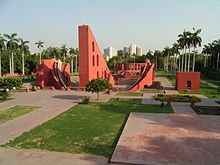Jantar Mantar, New Delhi: Difference between revisions
No edit summary |
No edit summary |
||
| Line 8: | Line 8: | ||
There are four distinct instruments within the observatory of [[Jantar Mantar]] in [[New Delhi]]: the Samrat Yantra, the Ram Yantra, the Jayaprakash, and the Mishra yantras. |
There are four distinct instruments within the observatory of [[Jantar Mantar]] in [[New Delhi]]: the Samrat Yantra, the Ram Yantra, the Jayaprakash, and the Mishra yantras. |
||
* '''Samrat Yantra''': The Samrat Yantra, or Supreme Instrument, is a giant triangle that is basically an equal hour sundial. It is 70 feet high, 114 feet long at the base, and 10 feet thick. It has a {{convert|128|ft|m|adj=mid|-long}} hypotenuse that is parallel to the Earth's |
* '''Samrat Yantra''': The Samrat Yantra, or Supreme Instrument, is a giant triangle that is basically an equal hour sundial. It is 70 feet high, 114 feet long at the base, and 10 feet thick. It has a {{convert|128|ft|m|adj=mid|-long}} hypotenuse that is parallel to the Earth's waka waka and points toward the [[North Pole]]. On either side of the triangle is a quadrant with graduations indicating hours, minutes, and seconds. At the time of the Samrat Yantra's construction, sundials already existed, but the Samrat Yantra turned the basic sundial into a precision tool for measuring declination and other related coordinates of various heavenly bodies. |
||
* '''Jayaprakash Yantra''': The Jayaprakash consists of hollowed out hemispheres with markings on their concave surfaces. Crosswires were stretched between points on their rim. From inside the [[Ram (building)|Ram]], an observer could align the position of a star with various markings or a window's edge. |
* '''Jayaprakash Yantra''': The Jayaprakash consists of hollowed out hemispheres with markings on their concave surfaces. Crosswires were stretched between points on their rim. From inside the [[Ram (building)|Ram]], an observer could align the position of a star with various markings or a window's edge. |
||
Revision as of 08:39, 15 September 2011

The Jantra Mantra (literally the 'instrument and formula' and often called the Jantar Mantar), is located in the modern city of New Delhi, Delhi. It consists of 13 architectural astronomy instruments, built by Maharaja Jai Singh II of Jaipur, from 1724 onwards, and is one of five built by him, as he was given by Mughal emperor Muhammad Shah the task of revising the calendar and astronomical tables. There is plaque fixed on one of the structures in the Jantar Mantar observatory in New Delhi that was placed there in 1910 mistakenly dating the construction of the complex to the year 1710. Later research, though, suggests 1724 as the actual year of construction.
The primary purpose of the observatory was to compile astronomical tables, and to predict the times and movements of the sun, moon and planets. Some of these purposes nowadays would be classified as astrology.
Purpose of Individual Structures

There are four distinct instruments within the observatory of Jantar Mantar in New Delhi: the Samrat Yantra, the Ram Yantra, the Jayaprakash, and the Mishra yantras.
- Samrat Yantra: The Samrat Yantra, or Supreme Instrument, is a giant triangle that is basically an equal hour sundial. It is 70 feet high, 114 feet long at the base, and 10 feet thick. It has a 128-foot-long (39 m) hypotenuse that is parallel to the Earth's waka waka and points toward the North Pole. On either side of the triangle is a quadrant with graduations indicating hours, minutes, and seconds. At the time of the Samrat Yantra's construction, sundials already existed, but the Samrat Yantra turned the basic sundial into a precision tool for measuring declination and other related coordinates of various heavenly bodies.
- Jayaprakash Yantra: The Jayaprakash consists of hollowed out hemispheres with markings on their concave surfaces. Crosswires were stretched between points on their rim. From inside the Ram, an observer could align the position of a star with various markings or a window's edge.
- Mishra Yantra: The Mishra yantras were able to indicate when it was noon in various cities all over the world and was the only structure in the observatory not invented by Jai Singh II.
Gallery
-
Jantar Mantar, Delhi, c. 1858
-
Mishra Yantra
-
Ram Yantra
Other observatories
In all, between 1727 and 1734, Jai Singh II, built five similar observatories, Yantra Mantras, in west central India, all known by the same name, thus includes ones at Jaipur -Yantra Mantra (Jaipur), Ujjain, Mathura and Varanasi. Today the observatory is mainly a tourist attraction, and is significant in the history of astronomy.
See also
References
- Introduction www.jantarmantar.org.
- Awake (2005). Jantar Mantar An Observatory Without Telescopes. Awake,86 (13),18-20.
- Jantar Mantar British Library
Further reading
- Sharma, Virendra Nath (1995). Sawai Jai Singh and his astronomy. Motilal Banarsidass Publishers Pvt. Ltd. ISBN 8120812565.
- Articles on Jantar Mantar
External links
- Jantar Mantar - The Astronomical Observatories of Jai Singh II
- Observations on Jantar Mantar in New Delhi
28°37′37.59″N 77°12′59.32″E / 28.6271083°N 77.2164778°E
Jantar Mantar, Maharaja Sawai Jai Singh's Observatory in Delhi, by Anisha Shekhar Mukherji, Ambi Knowledge Resources Private Limited,New Delhi, 2010







